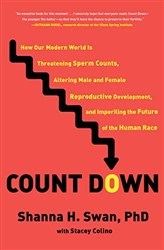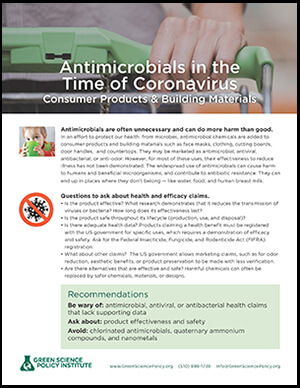April 2021 : COVID-19 and Dangerous Doorknobs
In this edition:
- Watch Now: Science and Communication Strategy for Change
- How to Have “Clean” Dust
- Avoiding Both Harmful Antimicrobials and COVID-19
- Toward Toxics-Free Online Shopping
- Welcome to Our New Science and Policy Fellow, Hannah Ray
- CALENDAR
I hope you are having a happy and healthy start to your spring. I’m delighted to have received both of my COVID vaccinations in time to enjoy beautiful days of cross-country skiing in the Teton and Sierra mountains before the snow melt.
Our Institute is also having a productive spring. After months of preparation, we piloted our Science and Communication Strategy Workshop for more than two dozen scientists from around the world—an advantage of Zoom meetings! We shared our successful strategy for translating scientific research into positive change and a healthier world for all.
The workshop detailed critical steps for releasing a scientific paper with impact, from asking the right research question to writing a compelling press release. You can learn our strategy from short presentations and resources here.
Has the pandemic made you wary of turning doorknobs and touching countertops? If so, you’re not alone—this concern has sparked a marketing frenzy for consumer and building products with added antimicrobial chemicals despite the fact that the virus is mostly airborne. Also the antimicrobials in most of these products do not provide any demonstrated health benefit, and instead may be harmful. Last week we released a statement with our NGO partners advising architects, designers, and building managers to avoid the unnecessary use of antimicrobials in building products. Thanks to our communications strategy, the statement was covered in popular building publications, including Architectural Record, Inhabitat, and Canadian Architect.
To learn about yet another class of harmful chemicals in buildings, please register here for our May 13 webinar on PFAS in building materials with noted attorney Rob Bilott. More info is in the calendar entry below.
In March we were honored to receive a leadership award from Shaw Industries for our work supporting “the wellbeing of people and the planet amid the unprecedented challenges of 2020.” Shaw, one of the world’s largest carpet manufacturers, has participated in our retreats and carpet industry workshops focused on finding innovative solutions to reduce the use of the Six Classes. Their collaboration with us was critical for the carpet industry stopping the use of all PFAS.
To appreciate the urgent need to reduce the use of PFAS and other harmful chemicals in consumer products, check out our colleague Shanna Swan’s new book, Count Down: How Our Modern World Is Threatening Sperm Counts, Altering Male and Female Reproductive Development, and Imperiling the Future of the Human Race. The book highlights shocking fertility statistics—including that sperm counts have dropped more than 50 percent over the past 40 years—and offers evidence that endocrine-disrupting chemicals are the major culprit. You can read a summary in Swan’s op-ed in Scientific American.
Reducing harm from such chemicals will require global coordination. If you are a scientist or medical or legal practitioner, please consider signing on in support of a global intergovernmental science-policy body on chemicals and waste. More than 1,300 individuals from more than 60 countries have already signed. The letter with signatories will be presented at the United Nations Environment Assembly in 2022.
Finally, I’m looking for a half-time personal/executive assistant for a mixture of remote and in-person work in North Berkeley. Excellent attention to detail, problem-solving, writing, research and computer skills, as well as a passion for reducing harm from toxic chemicals is required. A background in science would be helpful. To apply, please send a short cover letter including why you are interested in this position and your resume to [email protected].
Kind regards,
Arlene and the Green Science Policy team
Watch Now: Science and Communication Strategy for Change
Over the last decade, the Green Science Policy Institute has helped change government policy and business purchasing to protect human and environmental health from toxic chemicals. These successes have been based on our unique strategy for communicating scientific research. Indeed, four of the top 20 most-read articles in ES&T Letters were co-authored by our Institute.
To share our strategy with other scientists, we offered a free two-session online workshop. Scientists and communications experts shared inspirational stories and practical advice to increase the impact of scientific research. You can watch these talks below and download helpful resources from our website, including a communications plan worksheet, press release template, and embargo tip sheet.
Day 1 Talks– Impactful Science
- Arlene Blum, Green Science Policy Institute,
Science + Communication + Decision Makers = Positive Change
- Kathryn Rodgers, Silent Spring Institute,
Rachel Carson's Legacy: Connecting Science to Policy
- Miriam Diamond, University of Toronto,
Science and Communication for Change
Day 2 Talks– Strategic Communication
- Rebecca Fuoco, Green Science Policy Institute,
Making Your Science Newsworthy
- Amy Kostant, Science Communication Network,
Communicating Science through the Media
- Brandon Brown, University of San Francisco,
Improving Scientific Story-telling
How to Have “Clean” Dust
By Carol Kwiatkowski
More than 45 years ago, California enacted TB117, a flammability standard that led to large quantities of toxic flame retardants being added to upholstered furniture and children’s products throughout the US and Canada. Since then, we’ve learned that the flame retardants in our couches end up in our dust and our bodies - especially those of our children.
Now a peer-reviewed study, led by the Silent Spring Institute in collaboration with our Institute and others, indicates that the 2013 revision to TB117 so that flame retardants are no longer needed in furniture is making a real difference.
Study authors measured flame retardants in the dust of participants' homes. After their old upholstered furniture was replaced with new items without these chemicals, the researchers found a decrease in flame retardants. Results were similar for people who purchased new furniture and for those who only replaced the cushion foam with flame retardant free foam. Foam in cushions can be replaced before the furniture wears out, at a lower cost, and this will keep toxic furniture out of the secondhand market.
A recent similar study at Harvard assessed dust concentrations of PBDE and organophosphate flame retardants, as well as PFAS. Researchers found much lower levels of all of these harmful chemicals in areas that had been renovated with healthier furniture, carpet, and other products.
Until you complete your own healthy home make-over, you can reduce your family’s exposure to flame retardants and PFAS by wet-dusting and vacuuming with a HEPA filter often. Here’s to a future full of healthier homes! Many thanks to all the people and organizations who have worked so long and hard to achieve this policy and scientific success.
Avoiding Both Harmful Antimicrobials and COVID-19
By Anna Soehl
Yet another adverse impact of the pandemic is the overuse of antimicrobials due to concerns around contracting COVID-19 from surfaces. For example, the large family of widely used antimicrobials called quaternary ammonium compounds (QACs or quats), is associated with adverse health effects including asthma, allergen sensitivity, skin irritation, as well as respiratory, nervous system, immunological, reproductive and developmental effects. Because of this, Biomonitoring California's Scientific Guidance Panel recently voted unanimously to include the entire class of QACs on their priority chemicals list, a first step towards their possible regulation.
Disinfectants with less potential for health harm include those based on hydrogen peroxide, alcohol, citric acid, or lactic acid. The San Francisco Department of the Environment’s web tool lists disinfectants that contain safer ingredients approved by US EPA against COVID-19. Please share this information with those in charge of cleaning.
Also, you might like to check out our fact sheet Antimicrobials in the Time of Coronavirus: Consumer Products and Building Materials, our Six Classes video on antimicrobials, and this fun illustrated one-minute video on the Florence Statement.
Toward Toxics-Free Online Shopping
By Seth Rojello Fernández
Online shopping has expanded by 50 percent during the COVID-19 pandemic, with no signs of letting up. One disadvantage of virtual shopping is that sometimes we can’t see products or their packaging, which limits our ability to make informed decisions.
Clearya can help. A mobile app and browser extension, Clearya lists product ingredients and alerts the user if an ingredient has been found to be hazardous by scientists or regulators.
For example, Clearya will flag PFAS chemicals in single-use foodware. The app works on important items from personal care products to baby gear, and it can be used at online stores such as Amazon, Wal-Mart, and Sephora.
As vaccines roll out and we begin to transition back to our former way of life, let’s try to leave hazardous chemicals behind.
Welcome to Our New Science and Policy Fellow, Hannah Ray

We are pleased to welcome our new Science and Policy Fellow, Hannah Ray. Hannah is working on our Institute's projects on PFAS in building materials and outdoor gear and also antimicrobials. She enjoys canoe camping, pickup soccer, and playing with her young son. Hannah has a B.A. in chemistry from Wesleyan, and a Ph.D. in materials science and engineering from UC Berkeley. She has been a researcher at two renewable energy startups and a project manager at a window manufacturing company.
CALENDAR
April 22, 2021: Living Future 21
1:30pm Pacific
Arlene Blum will participate in a panel at the International Living Future Institute (ILFI) Living Furniture 21 meeting entitled "Transforming the Material Supply Chain: From the Lab Bench to the Job Site"
2:45pm Pacific
Tom Bruton and Seth Rojello Fernández of our Institute will give a talk at the ILFI Living Future 21 meeting. The title of their talk is: "Tracking Down Forever Chemicals in Building Products and Seeking Healthier Alternatives."
May 4, 2021: CalRecycle's 2021 "Haz-Madness" Symposium
9am Pacific
Arlene Blum will present the opening keynote on the Six Classes of Chemicals of Concern during the California Department of Resources Recycling and Recovery (CalRecycle) virtual 2021 Used Oil/HHW Haz-Madness Virtual Symposium on California's multitude of challenges with managing household hazardous waste.
May 13, 2021: Webinar: Eliminating Unnecessary PFAS in Building Materials
10am Pacific
Noted attorney Rob Bilott and Tom Bruton and Arlene Blum from our Institute will share surprising new information on PFAS and its uses in the built environment--from roofing to paint to concrete sealers and more. We will give an overview of the findings in our upcoming report and propose a path forward to reducing PFAS usage for healthier buildings, people, and environment. All green builders, architects, and designers should consider attending. Space is limited. Register here.
Receive Updates By Email
Subscribe to our monthly newsletter and get these updates delivered right to your inbox!





